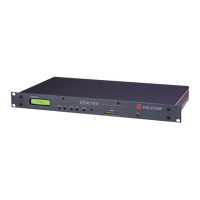INSTALLATION
VORTEX EF2211/EF2210 Reference Manual 12 Technical Support: 800.932.2774
close to the piece of equipment as possible. A 0 dB nominal level is a good standard
signal level. For example, a consumer VCR will probably generate a -8 dBu level.
As soon as the VCR signal arrives at an input with some gain control, the input gain
should be adjusted so that you get a 0 dB level, i.e. adding 8 dB of gain.
Check Levels to
the Codec
Configure the matrix mixer output to the codec input.
The output gain of the matrix mixer should be set to match the nominal input level of
the codec. For example, if the codec accepts -10 dBV (-8 dBu) inputs, 8 dB of atten-
uation should be applied at the matrix mixer output to the codec.
Configure the matrix mixer input from the codec output.
The input gain of the matrix mixer should be set to match the nominal output level of
the codec. For example, if the codec outputs a -10 dBV (-8 dBu) level, 8 dB of gain
should be applied on the matrix mixer input. This will bring the codec level up to 0
dBu inside the matrix.
Verify Room Gain After adjusting the loudspeaker level, verify the room gain in your system using the
R
OOM GAIN meter on the DIAGNOSTICS page of Conference Composer. Room gain
refers to the relative level of the audio going to your amplifier (remote end speech or
telephone speech) and the level of this audio being picked up by the microphone. The
Room Gain measurement is only accurate when just the remote talkers are speaking.
If local talkers are speaking too, the room gain meters are not accurate. See Figure 6
below. The meter shows the room gain, which is the relative level of the output level
and the input level. While the EF2211/EF2210 will operate in positive room gain
conditions, the room gain should be around 0 dB or a negative value. If you have a
positive room gain, make adjustments in the following areas:
1. Decrease the Input Gain of the microphone.
2. Decrease the Output Gain of the microphone.

